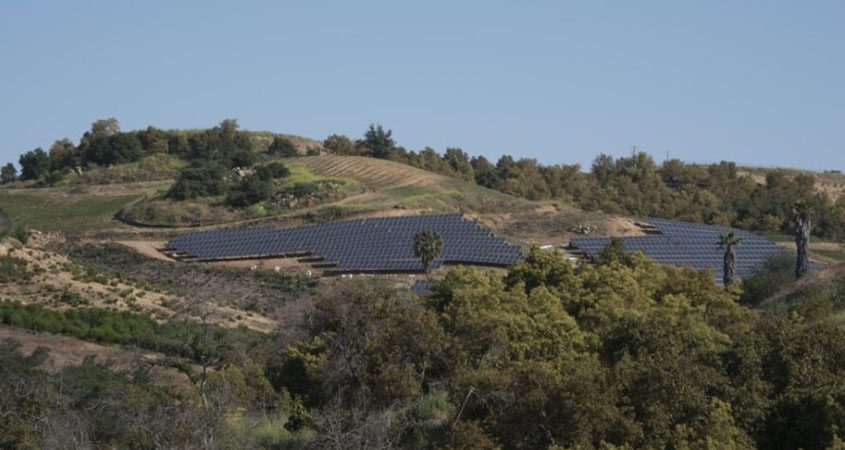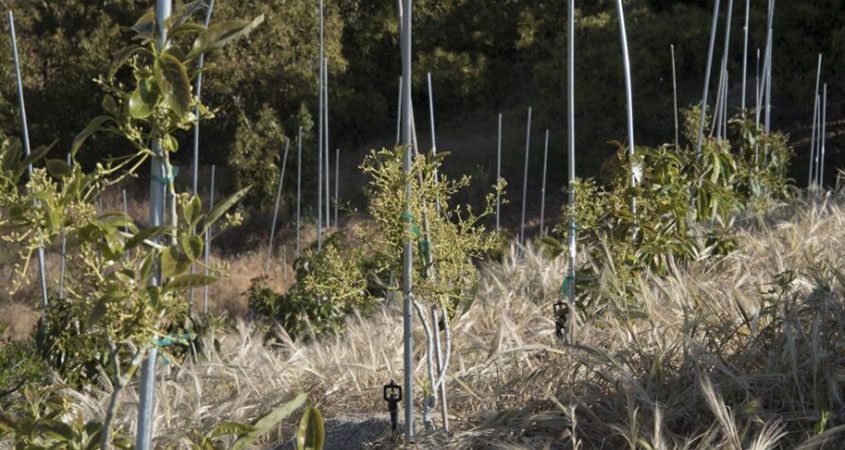Fallbrook Community Sees Drop in Water Bill. Will Other San Diegans See the Same?
Fallbrook residents are seeing a reduction in their water rates — all without having to make any changes. NBC 7’s Joe Little explains why.
Fallbrook residents are seeing a reduction in their water rates — all without having to make any changes. NBC 7’s Joe Little explains why.
San Diego County is home to more than 214,000 acres of agricultural land. Avocados, lemons, oranges and a variety of vegetables are grown in the county.
This week, during NPR’s Climate Solutions Week, we look at how San Diego County farmers are adapting to climate change with local growers Daniel and Paula Coxe, who grow avocados in Fallbrook, along with Amy Quandt, a San Diego State University professor who has surveyed farmers on the subject.
In modern American politics, voters at the local and state level are asked to weigh in all the time on ballot measures involving public policy. What’s strikingly consistent across the nation is just how contrary voters are and how ready they are to object to anything. In San Diego, for a local example, an utterly mundane 2016 measure to change the City Charter’s language on municipal bonds so that it conformed with the state Constitution and changes in state law drew the objections of 21 percent of voters. Very lopsided results are extremely rare.
The farming communities covered by the Rainbow Municipal Water District and Fallbrook Public Utilities District got permission in July to separate from the San Diego County Water Authority, the agency that buys water on behalf of the region and sells it to individual agencies. Now, voters in those two districts must approve the divorce.
Nearly 600,000 ballots are on their way to registered voters in the 4th Supervisorial District, City of Chula Vista, Fallbrook Public Utility District and Rainbow Municipal Water District for the Nov. 7 special election, the county registrar’s office announced today.
Josh Kane didn’t know a lot about avocado farming 10 years ago, but he does now.
In 2001, Kane’s mother bought a 60-acre avocado farm, the Rice Canyon Ranch, in Fallbrook, thinking it would be a good investment. But, some not-so-good advice, and the 2014 drought, had the business in a nosedive. Rice Canyon took a long-term investment perspective and invested in innovative measures, including tree stumping and grafting. Those strategies, along with smart irrigation, helped turn the farm around.
Josh Kane didn’t know a lot about avocado farming 10 years ago, but he does now.
In 2001, Kane’s mother bought a 60-acre avocado farm, the Rice Canyon Ranch, in Fallbrook, thinking it would be a good investment. But, some not-so-good advice, and the 2014 drought, had the business in a nosedive.
So, Kane quit his job in commercial real estate and stepped in to help his mom turn the farm around, or “they would have lost the investment,” said Kane.
During that time, the Fallbrook area had been a hub for agriculture, specifically avocados. But many farms ceased operating due to a complex suite of factors that include increasing water and labor costs, competition from imports, and climate volatility.
Rice Canyon took a long-term investment perspective and invested in innovative measures, including tree stumping and grafting. Those strategies, along with smart irrigation, helped turn the farm around. But challenges remain.
The Metropolitan Water District of Southern California Water Savings Incentive Program, or WSIP, helped Kane to increase water-use efficiency at the farm. Rice Canyon Ranch and Kane were recognized with an award. He was one of six honorees selected based on their remarkable water-saving projects and facility upgrades funded by the WSIP.
Each unique project was recognized in a May 2023 ceremony for its technological innovations, environmental stewardship and water sustainability.
Metropolitan’s One Water Awards ceremony at the California Endowment in Los Angeles honored organizations that used funding from the WSIP to make major improvements to their water management operations and equipment, such as installing smart irrigation technology, water recirculation systems and soil moisture sensors.

The Rice Canyon Ranch avocado farm. Photo: Metropolitan Water District of Southern California
“The transformation of daily operations for these organizations translates into long-term, sustainable change for entire communities,” said Metropolitan General Manager Adel Hagekhalil. “The ceremony demonstrated that when everyone does what they can to use less water, we produce real water savings that benefits millions.”
Named for Metropolitan’s approach to water management that values and acknowledges that all water resources are connected, the One Water Awards program amplifies the success of participants in its WSIP. The program provides funding to commercial, industrial, institutional and agricultural customers that make water efficiency upgrades to their facilities but may not qualify for Metropolitan’s standard commercial rebate programs. It pays up to $0.60 per 1,000 gallons of water saved annually through customized projects that are developed by each organization to fit its needs.
The WSIP program and incentives were critical to implementing Rice Canyon’s strategies and have helped significantly reduce costs.
Rice Canyon replaced existing, or old trees, with “high-density planting.” How did removing old trees and high-density planting save water and money?
Kane says Haas avocado trees reach up to “40 feet and out 50 feet, it’s a massive tree and older trees would climb higher and higher in the old way of growing.”
Instead of planting trees like the typical spacing for avocado farms in the past, the new trees were planted on 10 feet by 10 feet spacing. Kane says that change to smaller spacing allowed reduced water usage, reduced loss due to deep percolation, inhibited weed growth, and excessive evaporation loss through overgrown canopies. Plant “material changes” meant using mulch to save water.
“Avocado roots are only about six inches deep, so they require a lot of water,” Kane explained. “But adding a layer of mulch keeps the roots wet, reducing irrigation and saving water.”

The 60-acre Rice Canyon Ranch avocado farm is supplied with water from the San Diego County Water Authority and the Rainbow Municipal Water District, one of the Water Authority’s 24 member agencies. Photo: Metropolitan Water District of Southern California
“With the fruits on the canopy – and all the water needed to pull the water up to the canopy – a 9-foot-tall tree, cutting and pruning it back, is more efficient with the sun, space and way more efficient with the water,” said Kane.
Kane says before the changes in tree spacing, use of mulch, and smart irrigation, the water costs for the avocado farm were about $250,000 a year.
“Our water costs are about $62,000 a year now, a cut of roughly 75-percent, which is huge,” Kane said.
He said the farm received $238,000 from the WSIP program for the water-efficiency project and the operation now saves about 34-38 million gallons of water a year. Kane says the 10-year projected water savings is 350 million gallons.
Even with the grant, and all the changes to the farm – including smart irrigation techniques, Kane says competition from outside the U.S. is a big factor in making a profit.
“We’re giving it a go and trying, but the price per pound – with competition from a lot of overseas fruit, from Mexico, Argentina, Peru – is a key factor for us,” said Kane.
“Farming is not easy by any means,” said Kane. “The price we get for our avocados is about the same per pound today as we got 10 years ago. There are no guarantees, but the way we had to make it work was to reduce water expenses as much as we could.”
Kane has this advice to remain profitable for other growers of avocados or similar crops for smart irrigation.
“You have to think outside the box to make it, decrease expenses and increase profits – never stop learning,” said Kane. “Any old time farmer growing avocados the same way as 40 years ago, must change and adapt with the times.”
He says despite the water cost savings, use of water sensors and other changes, growing avocados for Rice Canyon is a tough business.
“It is a labor of love, not a business of income, but the water grant gets us closer to making it work,” said Kane.
(Editor’s Note: The Metropolitan Water District of Southern California is a water wholesaler. Since 1990, Metropolitan has invested nearly $1 billion in conservation programs, saving about 3.5 million acre-feet of water. Rice Canyon Ranch is supplied with water from the San Diego County Water Authority and the Rainbow Municipal Water District, one of the Water Authority’s 24 member agencies.)
San Diego is holding four special elections on Tuesday, Nov. 7, 2023. Understanding the “who, what, where when and how” of voting can be daunting. KPBS researched answers to frequently asked voter questions.
Voters will weigh in on four special elections in different parts of the County. Only those who live in the County’s Fourth Supervisorial District, the city of Chula Vista or in Fallbrook and Rainbow’s districts are eligible to vote in the special election.
In the county’s Fourth Supervisorial District voters will decide on who will fill the seat vacated by former Supervisor Nathan Fletcher and make the final choice among the top two vote-getters in the special general election — voting for either Monica Montgomery Steppe, a Democrat, attorney, and San Diego City Council president pro tem or Republican Amy Reichert, founder of ReOpen San Diego.
Voters in the city of Chula Vista will vote to fill the vacant City Attorney seat. This term expires in December 2026. Candidates include Bart Miesfeld, who served as a city attorney for Chula Vista in the past, Dan Smith Diaz, an attorney, and Marco Verdugo, also an attorney with Burke, Williams & Sorensen.
In Fallbrook and Rainbow voters will weigh in on whether the Fallbrook Public Utility District and the Rainbow Municipal Water District should detach from the San Diego County Water Authority and join the Eastern Municipal Water District.
By Alexander Nguyen / Multimedia Producer, North County
The San Diego county Board of Supervisors voted 3-1 Tuesday to support state legislation that would require a vote by all customers served by water districts within the County Water Authority before individual districts can leave the authority.
Proposed by Supervisor Joel Anderson in a board letter, the policy follows a July 10 decision from the San Diego Local Agency Formation Commission to allow the Rainbow Municipal Water District and Fallbrook Public Utility District to leave the water authority.
Nick Serrano, a board member of the San Diego County Water Authority and Deputy Chief of Staff to San Diego Mayor Todd Gloria said if Fallbrook and Rainbow detach from the water authority, the rest of the ratepayers in the county could see their bills increase as much as 5% per year.
“I think it’s stunning that there is an argument to not allow people to vote, that people do not deserve a say in this matter and we just disagree with that,” Serrano said. “I think at the very least, we believe that the ratepayers, who will be impacted by this decision, should have the opportunity to vote. It’s not to say that detachment can’t occur, but they have the opportunity to vote.”